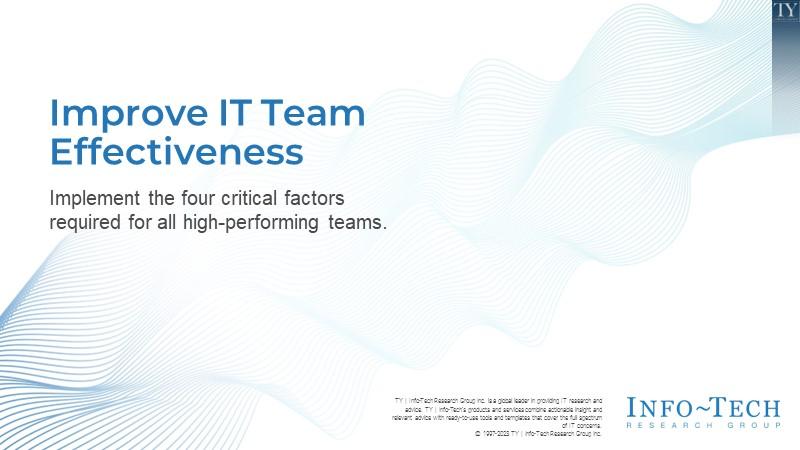
Improve IT Team Effectiveness
- Organizations rely on team-based work arrangements to provide organizational benefits and to help them better navigate the volatile, uncertain, complex, and ambiguous (VUCA) operating environment.
- This is becoming more challenging in a hybrid model as interactions now rely less on casual encounters and now must become more intentional.
- A high-performing team is more than productive. They are more resilient and able to recognize opportunities. They are proactive instead of reactive due to trust and a high level of communication and collaboration.
- IT teams are more unique, which also provides unique challenges other teams don’t experience.
Our Advice
Critical Insight
IT teams have:
- Multiple disciplines that tend to operate in parallel versus within a sequence of events.
- Multiple incumbent roles where people operate in parallel versus needing to share information to produce an outcome.
- Multiple stakeholders who create a tension with competing priorities.
Impact and Result
Use Info-Tech’s phased approach to diagnose your team and use the IDEA model to drive team effectiveness.
The IDEA model includes four factors to identify team challenges and focus on areas for improvement: identity, decision making, exchanges within the team, and atmosphere of team psychological safety.
Improve IT Team Effectiveness Research & Tools
Besides the small introduction, subscribers and consulting clients within this management domain have access to:
1. Team Effectiveness Storyboard – A step-by-step document that walks you through how to properly assess your team’s effectiveness and activities that will identify solutions to overcome.
The storyboard will walk you through three critical steps to assess, analyze, and build solutions to improve your team’s effectiveness.
- Improve IT Team Effectiveness Storyboard – Phases 1-3
2. The Team Effectiveness Survey – A tool that will determine what areas you are doing well in and where you can improve team relations and increase productivity.
Each stage has a deliverable that will support your journey on increasing effectiveness starting with how to communicate to the assessment which will accumulate into a team charter and action plan.
- IT Team Effectiveness Survey
- IT Team Effectiveness Survey Tool
3. Facilitation Guide – A collection of activities to select from and use with your team.
The Facilitation Guide contains instructions to facilitating several activities aligned to each area of the IDEA Model to target your approach directly to your team’s results.
- Improve IT Team Effectiveness Facilitation Guide
- Identity – Responsibilities and Dependencies
- Decision Making Accountability Workbook
- Exchanges – Team Communications Flow
- Exchanges – Communications Guide Poster Template
- Atmosphere – SCARF Worksheet
4. Action Plan – A template to help build your team action plan.
The Action Plan Template captures next steps for the team on what they are committing to in order to build a more effective team.
- Action Plan Template
5. Team Charter – A template to create a charter for a work group or project team.
A Team Charter captures the agreements your team makes with each other in terms of accepted behaviors and how they will communicate, make decisions, and create an environment that everyone feels safe contributing in.
- IT Team Charter Template
Infographic
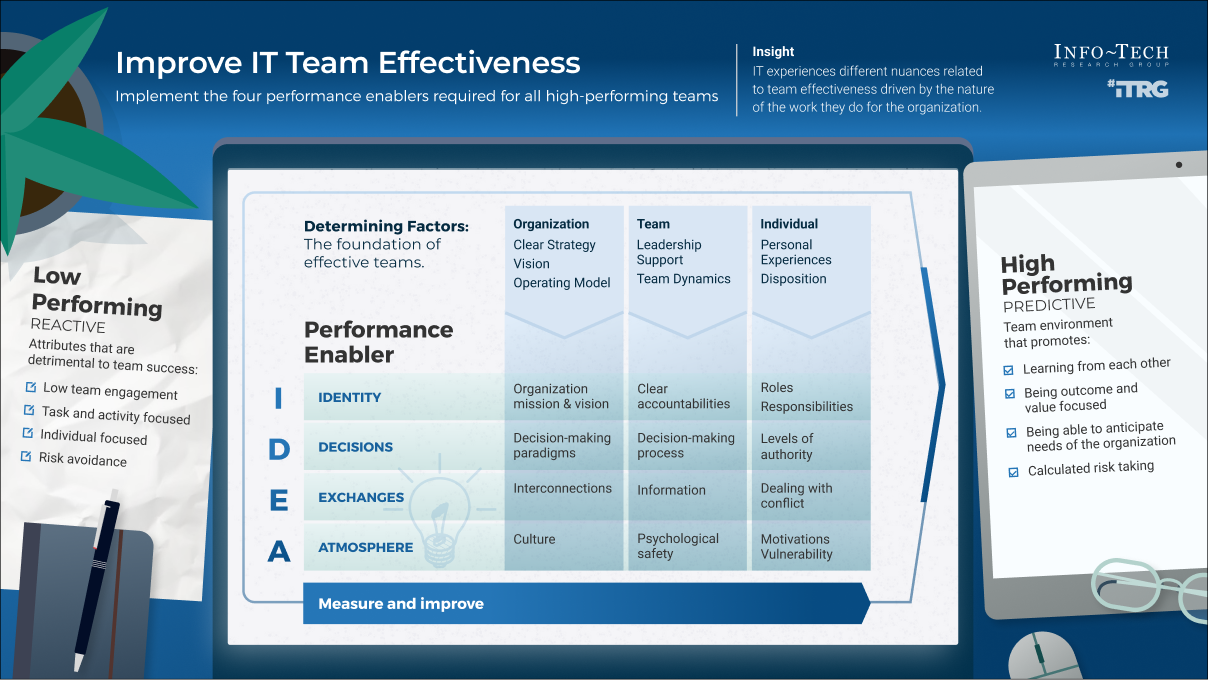
Workshop: Improve IT Team Effectiveness
Workshops offer an easy way to accelerate your project. If you are unable to do the project yourself, and a Guided Implementation isn't enough, we offer low-cost delivery of our project workshops. We take you through every phase of your project and ensure that you have a roadmap in place to complete your project successfully.
1 Assess the Team
The Purpose
Determine if proceeding is valuable.
Key Benefits Achieved
Set context for team members.
Activities
1.1 Review the business context.
1.2 Identify IT team members to be included.
1.3 Determine goals and objectives.
1.4 Build execution plan and determine messaging.
1.5 Complete IDEA Model assessment.
Outputs
Execution and communication plan
IDEA Model assessment distributed
2 Review Results and Action Plan
The Purpose
Review results to identify areas of strength and opportunity.
Key Benefits Achieved
As a team, discuss results and determine actions.
Activities
2.1 Debrief results with leadership team.
2.2 Share results with team.
2.3 Identify areas of focus.
2.4 Identify IDEA Model activities to support objectives and explore areas of focus.
Outputs
IDEA assessment results
Selection of specific activities to be facilitated
3 Document and Measure
The Purpose
Review results to identify areas of strength and opportunity.
Key Benefits Achieved
build an action plan of solutions to incorporate into team norms.
Activities
3.1 Create team charter.
3.2 Determine action plan for improvement.
3.3 Determine metrics.
3.4 Determine frequency of check-ins.
Outputs
Team Charter
Action Plan
Further reading
Improve IT Team Effectiveness
Implement the four critical factors required for all high-performing teams.
Analyst Perspective
All teams need to operate effectively; however, IT teams experience unique challenges.
IT often struggles to move from an effective to a high-performing team due to the very nature of their work. They work across multiple disciplines and with multiple stakeholders.
When operating across many disciplines it can become more difficult to identify the connections or points of interactions that define effective teams and separate them from being a working group or focus on their individual performance.
IT employees also work in close partnership with multiple teams outside their IT domain, which can create confusion as to what team are they a primary member of. The tendency is to advocate for or on behalf of the team they primarily work with instead of bringing the IT mindset and alignment to IT roadmap and goals to serve their stakeholders.
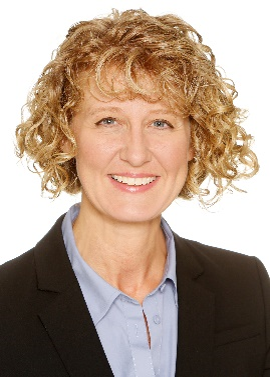
Amanda Mathieson
Research Director, People & Leadership Practice
Info-Tech Research Group
Executive Summary
The Challenge
Organizations rely on team-based work arrangements to provide organizational benefits and better navigate the volatile, uncertain, complex, and ambiguous (VUCA) operating environment.
This is becoming more challenging in a hybrid environment as interactions now rely less on casual encounters and must become more intentional.
A high-performing team is more than productive. They are more resilient and able to recognize opportunities. They are proactive instead of reactive due to the trust and high level of communication and collaboration.
Common Obstacles
IT teams are more unique, which also provides unique challenges other teams don't experience:
- Multiple disciplines that tend to operate in parallel versus within a sequence of events
- Multiple incumbent roles where people operate in parallel versus needing to share information to produce an outcome
- Multiple stakeholders that create a tension with competing priorities
Info-Tech's Approach
Use Info-Tech's phased approach to diagnose your team and use the IDEA model to drive team effectiveness.
The IDEA model includes four factors to identify team challenges and focus on areas for improvement: identity, decision making, exchanges within the team, and atmosphere of team psychological safety.
Info-Tech Insight
IT teams often fail to reach their full potential because teamwork presents unique challenges and complexities due to the work they do across the organization and within their own group. Silos, not working together, and not sharing knowledge are all statements that indicate a problem. As a leader it's difficult to determine what to do first to navigate the different desires and personalities on a team.
How this blueprint will help
Assess, diagnose, and address issues to realize your team's full potential.
This research helps IT support:
- Work Teams: Operate under one organizational unit or function. Their membership is generally stable with well-defined roles.
- Project Teams: Typically, are time-limited teams formed to produce a particular output or project. Their membership and expertise tend to vary over time.
- Management or Leadership Teams: Provide direction and guidance to the organization and are accountable for overall performance. Membership is structured by the hierarchy of the organization and includes a diverse set of skills, experience, and expertise.
Traditionally, organizations have tried to fix ineffective teams by focusing on these four issues: composition, leadership competencies, individual-level performance, and organizational barriers. While these factors are important, our research has shown it is beneficial to focus on the four factors of effective teams addressed in this blueprint first. Then, if additional improvement is needed, shift your focus to the traditional issue areas.
Common obstacles
These barriers make it difficult to address effectiveness for many IT teams:
- Teams do not use one standard set of processes because they may have a wide variety of assignments requiring different sets of processes.
Source: Freshworks
- There are multiple disciplines within IT that require vastly different skill sets. Finding the connection points can be difficult when on the surface it seems like success doesn't require interconnectivity.
- IT has many people in the same roles that act independently based on the stakeholder or internal customer they are serving. This can lead to duplication of effort if information and solutions aren't shared.
- IT serves many parts of the organization that can bring competing priorities both across the groups they support and with the IT strategy and roadmap itself. Many IT leaders work directly in or for the business, which can see them associate with the internal client team more than their IT team – another layer of conflicting priorities.
IT also experience challenges with maturity and data silos
48% |
of IT respondents rate their team as low maturity. Maturity is defined by the value they provide the business, ranging from firefighting to innovative partner. Source: Info-Tech Research Group, Tech Trends, 2022 |
|---|---|
20 Hours |
Data Silos: Teams waste more than 20 hours per month due to poor collaboration and communication. Source: Bloomfire, 2022 |
Current realities require teams to operate effectively
| How High-Performing Teams Respond: | |
|---|---|
Volatile: High degree of change happening at a rapid pace, making it difficult for organizations to respond effectively. |
Teams are more adaptable to change because they know how to take advantage of each others' diverse skills and experience. |
Uncertain: All possible outcomes are not known, and we cannot accurately assess the probability of outcomes that are known. |
Teams are better able to navigate uncertainty because they know how to work through complex challenges and feel trusted and empowered to change approach when needed. |
Complex: There are numerous risk factors, making it difficult to get a clear sense of what to do in any given situation. |
Teams can reduce complexity by working together to identify and plan to appropriately mitigate risk factors. |
Ambiguous: There is a lack of clarity with respect to the causes and consequences of events. |
Teams can reduce ambiguity through diverse situational knowledge, improving their ability to identify cause and effect. |
Teams struggle to realize their full potential
Poor Communication
To excel, teams must recognize and adapt to the unique communication styles and preferences of their members.
To find the "just right" amount of communication for your team, communication and collaboration expectations should be set upfront.
85% of tech workers don't feel comfortable speaking in meetings.
Source: Hypercontext, 2022
Decision Making
Decision making is a key component of team effectiveness. Teams are often responsible for decisions without having proper authority.
Establishing a team decision-making process becomes more complicated when appropriate decision-making processes vary according to the level of interdependency between team members and organizational culture.
20% of respondents say their organization excels at decision making.
Source: McKinsey, 2019
Resolving Conflicts
It is common for teams to avoid/ignore conflict – often out of fear. People fail to see how conflict can be healthy for teams if managed properly.
Leaders assume mature adults will resolve conflicts on their own. This is not always the case as people involved in conflicts can lack an objective perspective due to charged emotions.
56% of respondents prioritize restoring harmony in conflict and will push own needs aside.
Source: Niagara Institute, 2022
Teams with a shared purpose are more engaged and have higher performance
Increased Engagement
3.5x |
Having a shared team goal drives higher engagement. When individuals feel like part of a team working toward a shared goal, they are 3.5x more likely to be engaged. Source: McLean & Company, Employee Engagement Survey, IT respondents, 2023; N=5,427 |
|---|---|
90% |
Engaged employees are stronger performers with 90% reporting they regularly accomplish more than what is expected. Source: McLean & Company, Employee Engagement Survey, IT respondents, 2023; N=4,363 |
Effective and high-performing teams exchange information freely. They are clear on the purpose and goals of the organization, which enable empowerment.
Info-Tech Insight
Clear decision-making processes allow employees to focus on getting the work done versus navigating the system.
Case Study
Project Aristotle at Google – What makes a team effective at Google?
INDUSTRY: Technology
SOURCE: reWork
Challenge
Google wanted to clearly define what makes a team effective to drive a consistent meaning among its employees. The challenge was to determine more than quantitative measures, because more is not always better as it can just mean more mistakes to fix, and include the qualitative factors that bring some groups of people together better than others.
Solution
There was no pattern in the data it studied so Google stepped back and defined what a team is before embarking on defining effectiveness. There is a clear difference between a work group (a collection of people with little interdependence) and a team that is highly interdependent and relies on each other to share problems and learn from one another. Defining the different meanings took time and Google found that different levels of the organization were defining effectiveness differently.
Results
Google ended up with clear definitions that were co-created by all employees, which helped drive the meaning behind the behaviors. More importantly it was also able to define factors that had no bearing on effectiveness; one of which is very relevant in today's hybrid world – colocation.
It was discovered that teams need to trust, have clarity around goals, have structure, and know the impact their work has.
Overcoming barriers
Teams often lack the skills or knowledge to increase effectiveness and performance.
- Leaders struggle with team strife and ineffectiveness.
- A leader's ability to connect with and engage team members is vital for driving desired outcomes. However, many team leads struggle to deal with low-performing or conflict-ridden teams.
- Without adequate training on providing feedback, coaching, and managing difficult conversations, team leads often do not have the skills to positively affect team performance – and they do not appreciate the impact their actions have on desired outcomes.
- Team leads often find it difficult to invest time and resources in addressing challenges when the team is working toward deadlines.
- Team leads who are new to a management role within the organization often struggle to transition from independent contributor to leader – especially when they are tasked with managing team members who are former peers.
- Some team leads believe that soliciting help will be viewed as a personal failure, so they are reluctant to seek support for team performance management from more-senior leaders.
It's unrealistic to expect struggling teams to improve without outside help; if they were able to, they would have already done so.
To improve, teams require:
- A clearly defined team identity
- A clearly defined decision-making paradigm
- Consistently productive exchanges within the team
- An atmosphere of psychological safety
BUT these are the very things they are lacking when they're struggling.
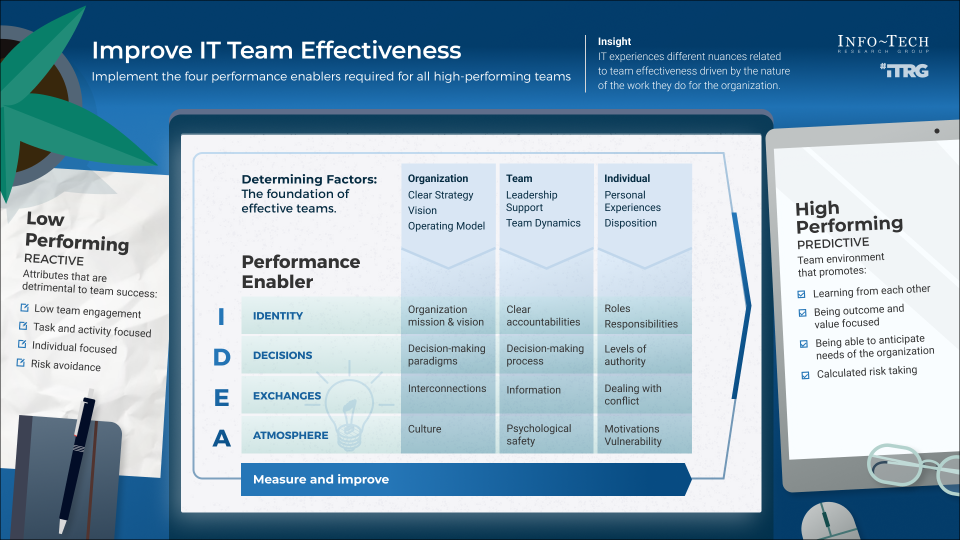
Improving team effectiveness
Use the Info-Tech IDEA Model to assess and improve your team's effectiveness.
Begin by assessing, recognizing, and addressing challenges in:
- Identity – team goals, roles, responsibilities, and accountabilities
- Decision-making paradigms and processes within the team.
- Exchanges of information, motivation, and emotions between team members
- Atmosphere of team psychological safety
IDEA Model of Team Effectiveness
Effective Team
- Identity
- Decisions
- Exchanges
- Atmosphere
Info-Tech offers various levels of support to best suit your needs
DIY Toolkit
“Our team has already made this critical project a priority, and we have the time and capability, but some guidance along the way would be helpful.”
Guided Implementation
“Our team knows that we need to fix a process, but we need assistance to determine where to focus. Some check-ins along the way would help keep us on track.”
Workshop
“We need to hit the ground running and get this project kicked off immediately. Our team has the ability to take this over once we get a framework and strategy in place.”
Consulting
“Our team does not have the time or the knowledge to take this project on. We need assistance through the entirety of this project.”
Diagnostics and consistent frameworks used throughout all four options
Guided Implementation
What does a typical GI on this topic look like?
| Phase 1: Assess the team | Phase 2: Review results and action plan | Phase 3: Document and measure |
|---|---|---|
Call #1: Scope requirements, objectives, and your specific challenges. |
Call #3: Review the assessment results and plan next steps. |
Call #6: Build out your team agreement. |
A Guided Implementation (GI) is a series of calls with an Info-Tech analyst to help implement our best practices in your organization.
A typical GI is 6 to 12 calls over the course of 4 to 6 months.
Workshop Overview
Contact your account representative for more information.
workshops@infotech.com 1-888-670-8889
Day 1 |
Day 2 |
Day 3 |
Day 4 |
|
|---|---|---|---|---|
Determine objectives and assess |
Review survey results |
Determine and conduct activities to increase effectiveness |
Bridge the gap and |
|
Activities |
With Leader – 1 hour |
2.1 Debrief results with leadership team. |
3.1 Conduct IDEA Model Activities:
3.2 Record outcomes and actions. |
4.1 Create team charter or agreement. |
Deliverables |
|
|
|
|
Phase 1
Assess the team
Phase 1 |
Phase 2 |
Phase 3 |
|---|---|---|
1.1 Identify team members |
1.1 Review results with team |
1.1 Document outcomes and actions |
Improving team effectiveness
Use the Info-Tech IDEA Model to assess and improve your team's effectiveness
Begin by assessing, recognizing, and addressing challenges in:
- Identity – team goals, roles, responsibilities, and accountabilities.
- Decision-making paradigms and processes within the team.
- Exchanges of information, motivation, and emotions between team members.
- Atmosphere of team psychological safety.
Effective Team
- Identity
- Decisions
- Exchanges
- Atmosphere
Assess the shared understanding of team identity
In addition to having a clear understanding of the team's goals and objectives, team members must also:
- Understand their own and each other's roles, responsibilities, and accountabilities.
- Recognize and appreciate the value of each team member.
- Realize how their actions impact each others' work and the overall goals and objectives.
- Understand that working in silos is considered a work group whereas a team coordinates activities, shares information, and supports each other to achieve their goals.
Clear goals enable employees to link their contributions to overall success of the team. Those who feel their contributions are important to the success of the department are two times more likely to feel they are part of a team working toward a shared goal compared to those who don't (McLean & Company, Employee Engagement Survey, IT respondents, 2023; N=4,551).
Goals matter in teamwork
The goals and objectives of the team are the underlying reason for forming the team in the first place. Without a clear and agreed-upon goal, it is difficult for teams to understand the purpose of their work.
Clear goals support creating clear roles and the contributions required for team success.

Assess the shared understanding of decision making
Decision making adds to the complexity of teamwork.
Individual team members hold different information and opinions that need to be shared to make good decisions.
Ambiguous decision-making processes can result in team members being unable to continue their work until they get clear direction.
The most appropriate decision-making process depends on the type of team:
- The higher the degree of interconnectivity in team members' work, the greater the need for a general consensus approach to decision making. However, if you opt for a general consensus approach, a backup decision-making method must be identified in the event consensus cannot be reached.
- High-pressure and high-stakes environments tend to centralize decision making to make important decisions quickly.
- Low-pressure and low-stakes environments are more likely to adopt consensus models.
Spectrum of Decision Making |
||
|---|---|---|
General consensus between all team members. |
A single, final decision maker within the team. |
|
Ensure team members understand how decisions are made within the team. Ask:
- Do team members recognize the importance of sharing information, opinions, and suggestions?
- Do team members feel their voices are heard?
- Must there be consensus between all team members?
- Is there a single decision maker?
Assess team exchanges by focusing on communication
Evaluate exchanges within your team using two categories:
These categories are related, but there is not always overlap. While some conflicts involve failures to successfully exchange information, conflict can also occur even when everyone is communicating successfully.
Communication |
Managing Conflict |
||
|---|---|---|---|
Information, motivations, emotions |
Accepting and expressing diverse perspectives |
Resolving conflict (unified action through diverse perspectives) |
|
Transmission |
Reception |
||
Success is defined in terms of how well information, motivations, and emotions are transmitted and received as intended. |
Success is defined in terms of how well the team can move to united action through differences of opinion. Effective teams recognize that conflict can be healthy if managed effectively. |
||
Successful exchange behaviors
- Shared understanding of how to motivate one another and how team members respond emotionally.
- Team moving beyond conflict to united action.
- Formalized processes used for resolving conflicts.
- Platforms provided for expressing diverse or conflicting perspectives and opinions – and used in a constructive manner.
- Use of agendas at meetings as well as clearly defined action items that reflect meeting outcomes.
- Avoidance of language that is exclusive, such as jargon and inside jokes.
Exchanges of information, emotion, and motivation
When selecting a method of communication (for example, in-person versus email), consider how that method will impact the exchange of all three aspects – not just information.
Downplaying the importance of emotional and motivational exchanges and focusing solely on information is very risky since emotional and motivational exchanges can impact human relationships and team psychological safety.
- Information: data or opinions.
- Emotions: feelings and evaluations about the data or opinions.
- Motivations: what we feel like doing in response to the data or opinions.
Communication affects the whole team
Effects are not limited to the team members communicating directly:
- How team members interact one on one transmits information and causes emotional and motivational responses in other group members not directly involved.
- How the larger group receives information, emotions, and motivations will also impact how individuals relate to each other in group settings.
Remember to watch the reactions and behavior of participants and observers when assessing how the team behaves.
Managing conflict
Identify how conflict management is embedded into team practices.
- Resolving conflicts is difficult and uses up a lot of time and energy. This is especially true if the team needs to figure out what to do each and every time people disagree.
- Teams that take the time to define conflict resolution processes upfront:
- Demonstrate their commitment to resolving conflict in a healthy way.
- Signal that diverse perspectives and opinions are valued, even if they spur disagreement sometimes.
- Are ready for conflict when it arises – prepared to face it and thrive.
Successfully communicating information, emotions, and motivations is not the same as managing conflict.
Teams that are communicating well are more likely to uncover conflicting perspectives and opinions than teams that are not.
Conflict is healthy and can be an important element of team success if it is managed.
The team should have processes in place to resolve conflicts and move to united action.
Assess the atmosphere
Team psychological safety
A team atmosphere that exists when all members feel confident that team members can do the following without suffering negative interpersonal consequences such as blame, shame, or exclusion:
- Admit mistakes
- Raise questions or concerns
- Express dissenting views
(Administrative Science Quarterly, 1999;
The New York Times, 2016)
What psychologically safe teams look like:
- Open and learning-focused approach to error.
- Effective conflict management within the team.
- Emotional and relational awareness between team members.
- Existence of work-appropriate interpersonal relationships between team members (i.e. beyond mere working relationships).
(Administrative Science Quarterly, 1999;
The New York Times, 2016)
What "team psychological safety" is not:
- A situation where all team members are friends.
In some cases psychologically safe team atmospheres might be harder to create when team members are friends since they might be more reluctant to challenge or disagree with friends. - Merely trust. Being able to rely on people to honor their commitments is not the same as feeling comfortable admitting mistakes in front of them or disagreeing with them.
"Psychological safety refers to an individual's perception of the consequences of taking an interpersonal risk or a belief that a team is safe for risk taking in the face of being seen as ignorant, incompetent, negative, or disruptive… They feel confident that no one on the team will embarrass or punish anyone else for admitting a mistake, asking a question, or offering a new idea."
– re:Work
Psychological safety
The impact of psychological safety on team effectiveness
Why does an atmosphere of team psychological safety matter?
- Prevents groupthink.
- People who do not feel safe to hold or express dissenting views gravitate to teams that think like they do, resulting in the well-known dangers of groupthink.
- Encourages contribution and co-operation.
- One study found that if team psychological safety is present, even people who tend to avoid teamwork will be more likely to contribute in team settings, thereby increasing the diversity of perspectives that can be drawn on (Journal of Organizational Culture, 2016).
Creating psychological safety in a hybrid environment requires a deliberate approach to creating team connectedness.
In the Info-Tech State of Hybrid Work in IT report autonomy and team connectedness present an interesting challenge in that higher levels of autonomy drove higher perceptions of lack of connectedness to the respondent's team. In a hybrid world, this means leaders need to be intentional in creating a safe team dynamic.
47% of employees who experienced more control over their decisions related to where, when, and how they work than before the pandemic are feeling less connected to their teams.
Source: Info-Tech, State of Hybrid Work in IT, 2022
1.1 Prepare to launch the survey
1-2 hours
- Review and record the objectives and outcomes that support your vision of a high-performing team:
- Why is this important to you?
- What reactions do you anticipate from the team?
- In your team meeting, share your vision of what a high-performing team looks like. Engage the team in a discussion:
- Ask how they work. Ask them to describe their best working team environment from a previous experience or an aspirational one.
- Option: Instruct them to write on sticky notes, one idea per note, and share. This approach will allow for theming of ideas.
- Introduce the survey as a way, together as a team, the current state can be assessed against the desired state discussed.
- Be clear that as the leader, you won't be completing the survey as you don't want to influence their perceptions of the team. As the leader, you hold authority, and therefore, experience the team differently. This is about them and their feedback.
Input
- Observations of team behavior
- Clearly articulated goals for team cohesion
Output
- Speaking notes for introducing survey
- Survey launch
Materials
- Whiteboard/flip charts
- Sticky notes
- IDEA Assessment
Participants
- Leader
- Team Members
Download the IT Team Effectiveness Survey
1.2 Launch the survey
1-2 hours
- Determine how the survey will be completed.
- Paper-based
- Email a copy of the Word document IT Team Effectiveness Survey for each person to complete individually.
- Identify one person to collect each survey and enter the results into the team effectiveness survey tool (tab 2. Data – Effectiveness Answers and tab 3. Data – Team Type Answers). This must be someone outside the team.
- Online direct input into Team Effectiveness Survey Tool
- Post the document in a shared folder.
- Instruct individuals to select one of the numbered columns and enter their information into tab 2. Data – Effectiveness Answers and tab 3. Data – Team Type Answers.
- To protect anonymity and keep results confidential, suggest each person opens document in "Cognito mode."
- Hide the Summary and Results tabs to avoid team members previewing them.
- Paper-based
Download the IT Team Effectiveness Survey Results Tool
Paper-Based Cautions & Considerations
- Heavily dependent on a trusted third party for genuine results
- Can be time consuming to enter the results
Online Direct Cautions & Considerations
- Ensure that users keep to the same numbered column across both entry tabs
- Seeing other team members' responses may influence others
- Least amount of administration
Phase 2
Review Results and Action Plan
Phase 1 | Phase 2 | Phase 3 |
|---|---|---|
1.1 Identify team members | 1.1 Review results with team | 1.1 Document outcomes and actions |
This phase will walk you through the following activities:
- Analyzing and debriefing the results to determine themes and patterns to come to a team consensus on what to focus on.
- Facilitated activities to drive awareness, build co-created definitions of what an effective team looks like, and identify solutions the team can undertake to be more effective.
This phase involves the following participants:
- Leader of the team
- All team members
Deliverables:
- A presentation that communicates the team assessment results
- A plan for effectively delivering the assessment results
Phase 2: Build a plan to review results and create an action plan
Reviewing assessment results and creating an improvement action plan is best accomplished through a team meeting.
Analyzing and preparing for the team meeting may be done by:
- The person charged with team effectiveness (i.e. team coach).
- For teams that are seriously struggling with team effectiveness, the coach should complete this step in its entirety.
- The team coach and the team lead.
- Truly effective teams are self-reliant. Begin upskilling team leads by involving team leads from the start.
- Analyze team assessment results
- Prepare to communicate results to the team
- Select team activities that will guide the identification of action items and next steps
- Facilitate the team meeting
2.1 Analyze results
Health Dials
- Once the results are final, review the Health Dials for each of the areas.
- For each area of the team's effectiveness
- Red indicates a threat – this will derail the team and you will require an external person to help facilitate conversations.
It would be recommended to contact us for additional guidance if this is one of your results. - Yellow is a growth opportunity.
- Green is a strength and pay attention to where the dial is – deep into strength or just past the line?
- Red indicates a threat – this will derail the team and you will require an external person to help facilitate conversations.
- Think about these questions and record your initial reactions.
- What surprises you – either positively or negatively?
- What areas are as expected?
- What behaviors are demonstrated that support the results?
- For each area of the team's effectiveness
Prioritize one to two factors for improvement by selecting those with:
- The lowest overall score.
- The highest variance in responses.
- If psychological safety is low, be sure to prioritize this factor; it is the foundation of any effective team.
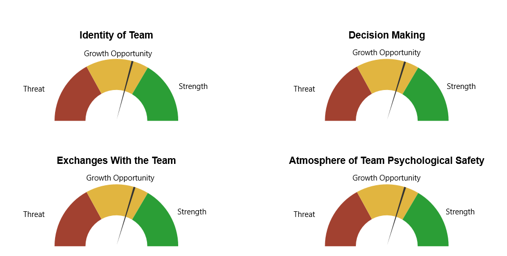
2.2 Analyze results
Alignment of Responses
- The alignment of responses area provides you with an overview of the range of responses from the team for each area.
- The more variety in the bars indicates how differently each person is experiencing the team.
- The more aligned the bars are the more shared the experiences.
The flatter the bars are across the top, the more agreement there was. Factors that show significant differences in opinion should be discussed to diagnose what is causing the misalignment within your team.
- Recommendation is to look at high scores and the alignment and lower scores and the alignment to determine where you may want to focus.
The alignment chart below shows varied responses; however, there are two distinct patterns. This will be an important area to review.
Things to think about:
- Are there new team members?
- Has there been a leadership change?
- Has there been a change that has impacted the team?
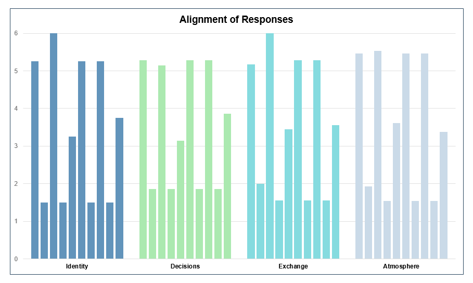
2.3 Analyze results
Team Characteristics and Stakes
- Team Characteristics. Use the Team Type Results tab in the IT Team Effectiveness Assessment Tool to identify how the team characterizes itself along the High-Low Scale. The closer the dark blue bar is to the right or left suggests to which degree the team views the characteristic.
- Interdependence highlights the team's view on how interconnected and dependent they are on each other to get work done. Think of examples where they should be sharing or collaborating, and they are not.
- Virtual describes the physicality of the team. This area has changed a lot since 2020; however, it's still important to note if the team shares the same understanding of work location. Are they thinking of team members in a different geography or referring to hybrid work?
- Decision making describes the scale of one decision maker or many. Where are most decisions made by on your team or who is making them?
- Stability refers to the degree to which the team stays the same – no membership change or turnover. It can be defined by length of time the group has been together. Looking at this will help understand alignment results. If alignment is varied, one might expect a less stable team.
- Stakes and Pressure
- Pressure refers to the conditions in which the team must work. How urgent are requests?
- Stakes refers to the degree of impact the work has. Will outputs impact safety, health, or a service?
- This category can be reviewed against decision making – high pressure, high stakes environments usually have a high concentration of authority. Low pressure, low stakes decisions can also be made either by one person as there is relatively no impact or with many as you have time to get many perspectives.
- This area informs what your decision-making protocols should look like.
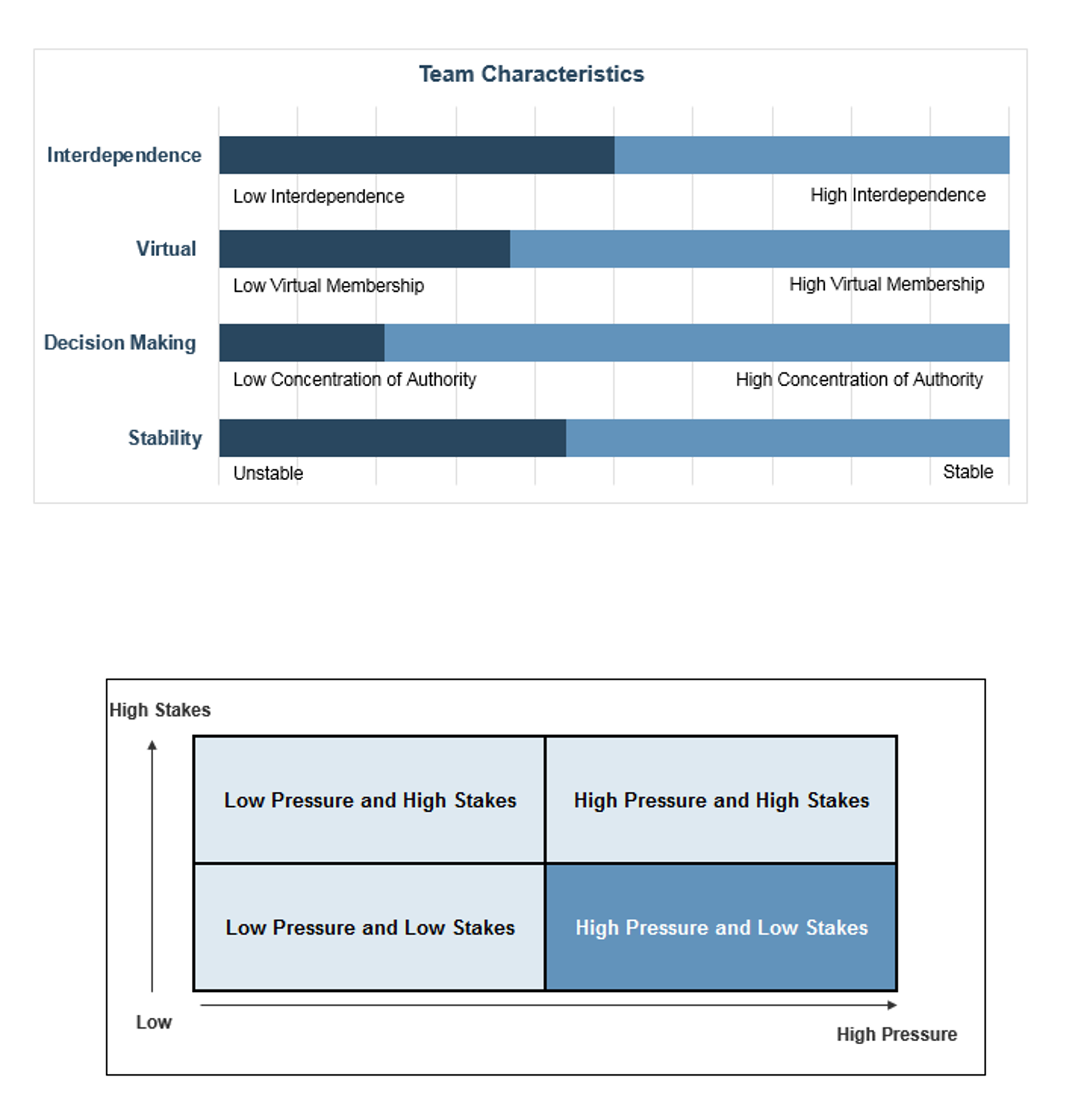
2.4 Prepare for meeting
1-2 hours
- Select a facilitator
- The right person to facilitate the meeting and present the results is dependent upon the results themselves, the team lead's comfort level, and the root and degree of team dysfunction.
- Typically, the team lead will facilitate and present the results. However, it will be more appropriate to have a member of the HR team or an external third party facilitate.
- Set the agenda (recommended sample to the right) that ensures:
- Team members reflect on the results and discuss reaction to the results. (E.g. Are they surprised? Why/why not?)
- Results are clearly understood and accepted by team members before moving on to activities.
- The aim of the meeting is kept in mind. The purpose of the team meeting is to involve all team members in the creation of an effectiveness improvement plan.
- Customize the Facilitation Guide and activities in the Improve IT Team Effectiveness Facilitation Guide. (Activities are aligned with the four factors in the IDEA model.)
- Identify a clear objective for each activity given the team assessment results. (E.g. What are the areas of improvement? What is the desired outcome of the activity?)
- Review and select the activities that will best achieve the objectives.
- Customize and prepare for chosen activities appropriately.
- Obtain all necessary materials.
- Practice by anticipating and preparing for questions, objectives, and what you will say and do.
Facilitation Factors
Select a third-party facilitator if:
- The team lead is uncomfortable.
- The leadership or organization is implicated in the team's dysfunction, a third party can be sought in place of HR.
- Regardless of who facilitates, it is critical that the team lead understands the process and results and is comfortable answering any questions that arise.
Agenda
- Review the IDEA Model.
- Discuss the assessment results.
- Invite team members to reflect on the results and discuss reaction to the results.
- Ensure results are clearly understood and accepted.
- Examine team challenges and strengths through selected team activities.
- Create a team charter and effectiveness improvement plan.
Materials
- IT Team Effectiveness Activities Facilitation Guide
- IT Team Effectiveness Survey results
Participants
- Leader
2.5 Run the meeting
2-3 hours
Facilitate the team meeting and agree on the team effectiveness improvement plan.
Work with the team to brainstorm and agree on an action plan of continuous improvements.
By creating an action plan together with the team, there is greater buy-in and commitment to the activities identified within the action plan.
Don't forget to include timelines and task owners in the action plan – it isn't complete without them.
Document final decisions in Info-Tech's Improve IT Team Effectiveness Action Plan Tool.
Review activity Develop Team Charter in the Improve IT Team Effectiveness Facilitation Guide and conclude the team meeting by creating a team charter. With a team charter, teams can better understand:
- Team objectives
- Team membership and roles
- Team ground rules
Facilitation Factors
Encourage and support participation from everyone.
Be sure no one on the team dismisses anyone's thoughts or opinions – they present the opportunity for further discussion and deeper insight.
Watch out for anything said or done during the activities that should be discussed in the activity debrief.
Debrief after each activity, outlining any lessons learned, action items, and next steps.
Agenda
- Review the IDEA Model.
- Discuss the assessment results.
- Invite team members to reflect on the results and discuss reaction to the results.
- Ensure results are clearly understood and accepted.
- Examine team challenges and strengths through selected team activities.
- Create a team charter and effectiveness improvement plan.
Materials
- IT Team Effectiveness Activities Facilitation Guide
- Whiteboard/flip charts
- Sticky notes
- IT Team Effectiveness Survey results
Participants
- Leader
- Team Members
- Optional – External Facilitator
Phase 3
Document and measure
Phase 1 | Phase 2 | Phase 3 |
|---|---|---|
1.1 Identify team members | 1.1 Review results with team | 1.1 Document outcomes and actions |
This phase will walk you through the following activities:
Building your team charter that will include:
- Team vision, mission, and goals
- Roles and responsibilities of each member
- Decision-making responsibilities and process
- How information will be shared and by whom
- Ways to build psychological safety on the team
This phase involves the following participants:
- Leader of the team
- All team members
Document and agree to regular check-ins to reassess.
As a team it will be important to drive your brainstormed solutions into an output that is co-created.
- Agree to what actions can be implemented.
- Capture agreed-to team goals, roles, responsibilities, and decision process into a team charter. Also include your communication protocol that articulates how information will be shared in future.
- Review suggestions and actions
- Capture in team charter
- Assign metrics to measure success and determine when to review
- Complete ongoing check-ins with team through team meeting and plan to reassess if agreed to
Team Charter
Never assume everyone "just knows."
Set clear expectations for the team's interactions and behaviors.
- Some teams call this a team agreement, team protocol, or ways of working. Determine the naming convention that works best for your team and culture.
- This type of document saw a renewed popularity during COVID-19 as face-to-face interactions were more difficult, and as teams, news ways to work needed to be discovered, shared, and documented.
- A co-created team charter is a critical component to onboarding new employees in the hybrid world.
Info-Tech Insight – State of Hybrid Work in IT
One contributor to the report shared the effort and intention around maintaining their culture during the pandemic. The team agreement created became a critical tool to enable conversations between leaders and their team – it was not a policy document.
Team effectiveness is driven through thoughtful planned conversations. And it's a continued conversation.
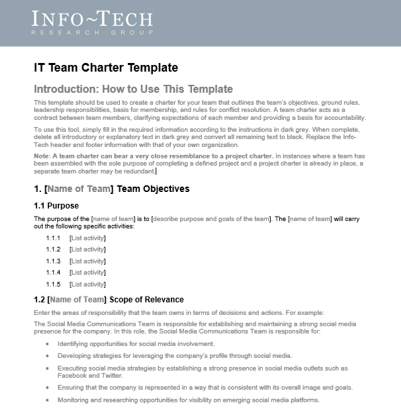
Download the IT Team Charter Template
Establish Baseline Metrics
Baseline metrics will be improved through:
Identify the impact that improved team effectiveness will have on the organization.
Determine your baseline metrics to assess the success of your team interventions and demonstrate the impact to the rest of the organization using pre-determined goals and metrics.
Share success stories through:
- Newsletters or email announcements
- Team meetings
- Presentations to business partners or the organization
Sample effectiveness improvement goal |
Sample Metric |
|---|---|
Increase employee engagement |
|
Strengthen manager/employee relationships |
|
Reduce employee turnover (i.e. increase retention) |
|
Increase organizational productivity |
|
Reassess team effectiveness
Reassess and identify trends after they have worked on key focus areas for improvement.
Track the team's progress by reassessing their effectiveness six to twelve months after the initial assessment.
Identify if:
- Team characteristics have changed.
- Areas of team strengths are still a source of strength.
- Areas for improvement have, in fact, improved.
- There are opportunities for further improvement.
As the team matures, priorities and areas of concern may shift; it is important to regularly reassess team effectiveness to ensure ongoing alignment and suitability.
Note: It is not always necessary to conduct a full formal assessment; once teams become more effective and self-sufficient, informal check-ins by team leads will be sufficient.
If you assess team effectiveness for multiple teams, you have the opportunity to identify trends:
- Are there common challenges within teams?
- If so, what are they?
- How comfortable are teams with intervention?
- How often is outside help required?
Identifying these trends, initiatives, training, or tactics may be used to improve team effectiveness across the department – or even the organization.
Teams are ultimately accountable for their own effectiveness.
As teams mature, the team lead should become less involved in action planning. However, enabling truly effective teams takes significant time and resources from the team lead.
Use the action plan created and agreed upon during the team meeting to hold teams accountable:
- Ensure teams follow through on action items.
- Ensure you are continuously assessing team effectiveness (formally or informally).
The team coach should have a plan to transition into a supportive role by:
- Providing teams with the knowledge, resources, and tools required to improve and sustain high effectiveness.
- Providing team members and leads with a safe, open, and honest environment.
- Stepping in as an objective third party when required.
If the team continues to face barriers
Other important information: If team effectiveness has not significantly improved, other interventions may be required that are beyond the scope of this project.
The four factors outlined in the IDEA Model of team effectiveness are very important, but they are not the only things that have a positive or negative impact on teams. If attempts to improve the four factors have not resulted in the desired level of team effectiveness, evaluate other barriers:
For organizational culture, ask if performance and reward programs do the following:
- Value teamwork alongside individual achievement and competition
- Provide incentives that promote a focus on individual performance over team performance
- Reward or promote those who sabotage their teams
For learning and development, ask:
- Is team effectiveness included in our manager or leadership training?
- Do we offer resources to employees seeking to improve their teamwork competencies?
If an individual team member's or leader's performance is not meeting expectations, potential remedies include a performance improvement plan, reassignment, and termination of employment.
These kinds of interventions are beyond the control of the team itself. In these cases, we recommend you consult with your HR department; HR professionals can be important advocates because they possess the knowledge, influence, and authority in the company to promote changes that support teamwork.
Related Info-Tech Research
Redesign Your IT Department
- You could have the best IT employees in the world, but if they aren't structured well your organization will still fail in reaching its vision.
- Increase the effectiveness of IT as a function.
- Provide employees with clarity in their roles and responsibilities.
Build an IT Employee Engagement Program
- With the growing IT job market, turnover is a serious threat to IT's ability to deliver seamless value and continuously drive innovation.
- Engagement initiatives are often seen as being HR's responsibility; however, IT leadership needs to take accountability for the retention and productivity of their employees in order to drive business value.
- Development of the leadership mind should never stop. This program will help IT leaders continue to craft their leadership competencies to navigate the ever-changing world in which we operate.
- Actively delegate responsibilities and opportunities that engage and develop team members to build on current skills and prepare for the future.
Research Contributors and Experts

Carlene McCubbin
Practice Lead
Info-Tech Research Group

Nick Kozlo
Senior Research Analyst
Info-Tech Research Group

Heather Leier-Murray
Senior Research Analyst
Info-Tech Research Group

Stephen O'Conner
Executive Counselor
Info-Tech Research Group

Jane Kouptsova
Research Director
Info-Tech Research Group

Dr. Julie D. Judd, Ed.D.
Chief Technology Officer
Ventura County Office of Education
Works Cited
Aminov, I., A. DeSmet, and G. Jost. "Decision making in the age of urgency." McKinsey. April 2019. Accessed January 2023.
Duhigg, Charles. "What Google Learned From Its Quest to Build the Perfect Team." The New York Times, 25 Feb. 2016. Accessed January 2023.
Edmondson, Amy. "Psychological Safety and Learning Behavior in Work Teams." Administrative Science Quarterly, vol. 44, no. 2, June 1999, pp. 350-383.
Gardner, Kate. "Julie Judd – Ventura County Office of Education." Toggle, 12 Sept. 2022. Accessed January 2023.
Google People Operations. "Guide: Understand Team Effectiveness." reWork, n.d. Accessed February 2023.
Harkins, Phil. "10 Leadership Techniques for Building High-Performing Teams." Linkage Inc., 2014. Accessed 10 April 2017.
Heath, C. and D. Heath. Decision: How to make better choices in life and work. Random House, 2013, ISBN 9780307361141.
Hill, Jon. "What is an Information Silo and How Can You Avoid It." Bloomfire, 23 March 2022. Accessed January 2023.
"IT Team Management Software for Enhanced Productivity." Freshworks, n.d. Accessed January 2023.
Jackson, Brian. "2022 Tech Trends." Info-Tech Research Group, 2022. Accessed December 2022.
Kahneman, Daniel. Thinking fast and slow. Farrar, Straus and Giroux. 2011.
Kouptsova, J., and A. Mathieson. "State of Hybrid Work in IT." Info-Tech Research Group, 2023. Accessed January 2023.
Mayfield, Clifton, et al. "Psychological Collectivism and Team Effectiveness: Moderating Effects of Trust and Psychological Safety." Journal of Organizational Culture, Communications and Conflict, vol. 20, no. 1, Jan. 2016, pp. 78-94.
Rock, David. "SCARF: A Brain-Based Model for Collaborating With and Influencing Others." NeuroLeadership Journal, 2008. Web.
"The State of High Performing Teams in Tech Hypercontext." Hypercontext. 2022. Accessed November 2022.
Weick, Carl, and Kathleen Sutcliff. Managing the unexpected. John Wiley & Sons, 2007.
"Workplace Conflict Statistics: How we approach conflict at work." The Niagara Institute, August 2022. Accessed December 2022.